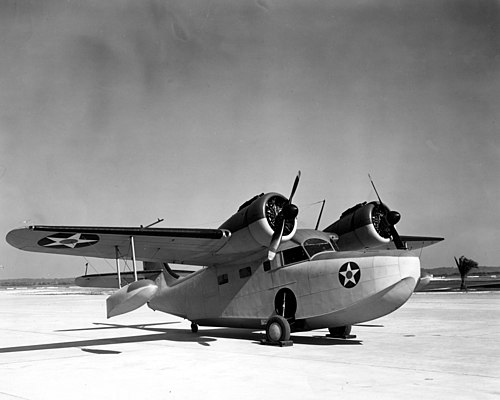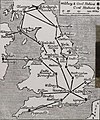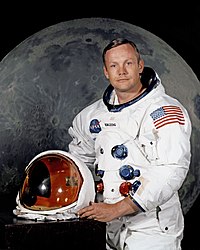Portal:Aviation
| Main page | Categories & Main topics |
|
Tasks and Projects |
The Aviation Portal

Aviation includes the activities surrounding mechanical flight and the aircraft industry. Aircraft includes fixed-wing and rotary-wing types, morphable wings, wing-less lifting bodies, as well as lighter-than-air craft such as hot air balloons and airships.
Aviation began in the 18th century with the development of the hot air balloon, an apparatus capable of atmospheric displacement through buoyancy. Some of the most significant advancements in aviation technology came with the controlled gliding flying of Otto Lilienthal in 1896; then a large step in significance came with the construction of the first powered airplane by the Wright brothers in the early 1900s. Since that time, aviation has been technologically revolutionized by the introduction of the jet which permitted a major form of transport throughout the world. (Full article...)
Selected article
Selected image
Did you know
...that British Airways unveiled a new corporate identity in 1997 which involved repainting its fleet with around 20 daring tailfin designs by world artists? ...that Theo Osterkamp was the first German reconnaissance pilot to fly a land-based aircraft to England during World War I? ... that Chesley "Sully" Sullenberger, the captain of US Airways Flight 1549, also runs an aviation safety consultant company and has worked as an accident investigator for the USAF, NTSB, and FAA?
General images -
In the news
- May 29: Austrian Airlines cancels Moscow-bound flight after Russia refuses a reroute outside Belarusian airspace
- August 8: Passenger flight crashes upon landing at Calicut airport in India
- June 4: Power firm helicopter strikes cables, crashes near Fairfield, California
- January 29: Former basketball player Kobe Bryant dies in helicopter crash, aged 41
- January 13: Iran admits downing Ukrainian jet, cites 'human error'
- January 10: Fire erupts in parking structure at Sola Airport, Norway
- October 27: US announces restrictions on flying to Cuba
- October 3: World War II era plane crashes in Connecticut, US, killing at least seven
- September 10: Nevada prop plane crash near Las Vegas leaves two dead, three injured
- August 6: French inventor Franky Zapata successfully crosses English Channel on jet-powered hoverboard
Related portals
Associated Wikimedia
The following Wikimedia Foundation sister projects provide more on this subject:
-
Commons
Free media repository -
Wikibooks
Free textbooks and manuals -
Wikidata
Free knowledge base -
Wikinews
Free-content news -
Wikiquote
Collection of quotations -
Wikisource
Free-content library -
Wikiversity
Free learning tools -
Wikivoyage
Free travel guide -
Wiktionary
Dictionary and thesaurus
Selected biography
Before becoming an astronaut, Armstrong was in the United States Navy and saw action in the Korean War. After the war, he served as a test pilot at the National Advisory Committee for Aeronautics (NACA) High-Speed Flight Station, now known as the Dryden Flight Research Center, where he flew over 900 flights in a variety of aircraft. As a research pilot, Armstrong served as project pilot on the F-100 Super Sabre A and C aircraft, F-101 Voodoo, and the Lockheed F-104A Starfighter. He also flew the Bell X-1B, Bell X-5, North American X-15, F-105 Thunderchief, F-106 Delta Dart, B-47 Stratojet, KC-135 Stratotanker and Paresev. He graduated from Purdue University.
Selected Aircraft

The Airbus A380 is a double-deck, four-engined airliner manufactured by Airbus S.A.S. It first flew on 27 April 2005 from Toulouse–Blagnac Airport. Commercial flights began in late 2007 after months of testing, with the delivery of the first aircraft to launch customer Singapore Airlines. During much of its development phase, the aircraft was known as the Airbus A3XX, and the nickname Superjumbo has also become associated with the A380.
The A380 is double decked, with the upper deck extending along the entire length of the fuselage. This allows for a spacious cabin, with the A380 in standard three-class configuration to seat 555 people, up to maximum of 853 in full economy class configuration. Only one model of the A380 was available: The A380-800, the passenger model. It is the largest passenger airliner in the world superseding the Boeing 747. The other launch model, the A380-800F freighter, was canceled and did not join the ranks of the largest freight aircraft such as the Antonov An-225, An-124, and the C-5 Galaxy.
- Span: 79.8 m (261 ft 10 in)
- Length: 73 m (239 ft 6 in)
- Height: 24.1 m (79 ft 1 in)
- Engines: 4 * Rolls-Royce Trent 900 or Engine Alliance GP7200 (311 kN or 69,916 lbf)
- Cruising Speed: 0.85 Mach (approx 1,050 km/h or 652 mph or 567 kn)
- First Flight: 27 April 2005
- Number built: 254 (including 3 prototypes)
Today in Aviation
- 2011 – The Dubai-based airline Emirates orders 50 Boeing 777 airliners worth about US$18,000,000,000 – the largest order in terms of commercial value in Boeing's history – with an option to purchase 20 more 777s for another $8,000,000,000.[1]
- 2008 – An Antonov An-12 crashes after takeoff from Al Asad Air Base, killing all 7 crew members.[2] Six members of the crew and one passenger died, three of them were Russians. The crew also consisted of a Belarusian, two Ukrainians and an Indian citizen.[3]
- 1993 – China Northern Airlines Flight 6901, a McDonnell Douglas MD-82, crashes on approach to Ürümqi Diwopu International Airport, Xinjiang, China; killing 12 of the 102 on board; pilot error is blamed.
- 1992 – The famous ‘golf balls’ at RAF Fylingdales were replaced in service by the three sided pyramid structure of the new AN/FPS-115 phased-array radar.
- 1992 – First flight of the Progressive Aerodyne SeaRey
- 1981 – Ben Abruzzo and crew make the first crossing of the Pacific Ocean by balloon, in the Double Eagle V
- 1966 – All Nippon Airways Flight 533, a NAMC YS-11, plunges into Seto Inland Sea after an overrun at Matsuyama Airport, Shikoku, Japan, killing all 50 passengers and crew; this crash is the first loss of a YS-11.
- 1958 – Seventh of 13 North American X-10s, GM-19313, c/n 7, on X-10 Drone BOMARC target mission 2, out of Cape Canaveral, Florida. The X-10 flies out over the ocean, then accelerates toward the Cape. However the Bomarc A fails to launch. Autoland is successful, but again the drag chute and landing barrier both fail, and the vehicle burns after overrunning the runway.
- 1951 – A USAF Fairchild C-82A-FA Packet, 45-57801, c/n 10171, 'CQ-801', of the 11th Troop Carrier Squadron, 60th Troop Carrier Group, en route from Rhein-Main Air Base, Germany to Bordeaux–Mérignac Airport, France, goes off-course due to wind drift, compounded with having received weather briefings for 8,000 feet (2,400 m), but flew at 6,000 feet (1,800 m), hits the side of Mt. Dore in poor weather at ~1300 hrs., 20 miles (32 km) SW of Clermont-Ferrand, France. Six crew and 30 passengers all killed. It was transporting US Army postal workers to set up a military post office at Bordeaux, France. This remains the worst all-time C-82 accident in terms of human loss.
- 1950 – The 1950 Tête de l'Obiou C-54 crash: A Curtiss Reid Flying Services-operated C-54 Skymaster crashes 30 mi (48 km) from Grenoble, France on the Tête de l'Obiou mountain; all 52 passengers and crew die.
- 1944 – civil air services to London are restored, with the first flights carried out by Railway Air Services
- 1943 – American preparatory bombing for the amphibious landings in the Gilbert Islands begins with a strike by 17 U. S. Army Air Forces B-24 Liberators against Japanese forces on Betio island at Tarawa Atoll. For the next week, B-24s raid Betio, Butaritari, or both every day, Mili four times, and Jaluit and Maloelap twice each, destroying several Japanese aircraft. Japanese aircraft strike Nanumea and Funafuti once each, destroying one B-24 and damaging two.
- 1942 – A U. S. Navy OS2U Kingfisher floatplane rescues U. S. World War I ace Eddie Rickenbacker and two other survivors of a ditched B-17D Flying Fortress from a life raft. They had been adrift in the Pacific for 22 days.
- 1940 – Introduction: Handley Page Halifax with the Royal Air Force’s No. 35 Squadron
- 1926 – Schneider Trophy race flown at Hampton Roads, USA. Won by Mario De Bernardi (Italy) in a Macchi M.39 at 396.698 km/h (246.5 mph).
- 1916 – Sole prototype of the Zeppelin-Lindau (Dornier) V1, a single-seat, all-metal fighter with pod-type fuselage and pusher 160 hp (120 kW) Maybach Mb III engine, designed by Dipl-Ing Claudius Dornier, and built by the Abteilung 'Dornier' of the Luftschiffbau Zeppelin GmbH at Seemoos, near Friedrichshafen, attempts initial flight. After a series of ground hops in September by Bruno E. Schröter, this pilot refused to fly the prototype due to pronounced tail-heaviness. Oblt. Haller von Hallerstein, instead undertakes initial flight this date, but the V1 performs a loop immediately after take-off, crashing, killing pilot. No further development undertaken of the type.
- 1915 – Flying a BE.2c, Royal Naval Air Service Flight Commander J. R. W. Smyth-Pigott makes a daring night bombing attack on a bridge of the Berlin-Constantinople railway over the Maritsa River at Kuleli Burgas in the Ottoman Empire from an altitude of 300 feet (91 meters). Although the bridge sruvives, he receives the Distinguished Service Order for gallantry.
- 1907 – First flight of the Cornu helicopter
- 1906 – Alberto Santos-Dumont flies the Santos-Dumont 14-bis a distance of 722 feet (220 m) in 21 seconds on the grounds of the Château de Bagatelle. With the event happening after over two years of successful Wright brothers flights in the United States, this is recorded as the first officially observed aeroplane flight in Europe and the distance Santos-Dumont flies is the first officially recognized airplane distance record.
References
- ^ Reuters, "Emirates Airline Places Big Order for Boeing Jets", newyorktimes.com, 13 November 2011
- ^ "ASN Aircraft accident Antonov 12 Al Asad AB". ASN Aviation Safety Database. Aviation Safety Network. 2008-11-13. Retrieved 2008-11-14.
- ^ "Three Russians killed in Iraqi plane crash". Russia Today. 2008-11-15. Retrieved 2008-11-15.
- Shortcuts to this page: Portal:Airplanes • P:AVIA






















































